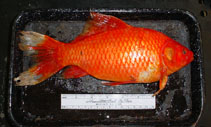| Family: |
Cyprinidae (Minnows or carps), subfamily: Cyprininae |
| Max. size: |
48 cm TL (male/unsexed); max.weight: 1,598.6 g; max. reported age: 41 years |
| Environment: |
benthopelagic; freshwater; brackish; pH range: 6 - 8; dH range: 5 - 19; depth range 0 - 20 m, potamodromous |
| Distribution: |
Asia: native in East Asia, China and Japan (Ref. 6390). Introduced elsewhere. throughout the world with reported adverse ecological impact after introduction. |
| Diagnosis: |
Dorsal spines (total): 3-4; Dorsal soft rays (total): 14-20; Anal spines: 2-3; Anal soft rays: 4-7; Vertebrae: 30-30. Body stout, thick-set, caudal peduncle thick and short (Ref. 1998). Head without scales (Ref. 39167, 1998), broadly triangular (Ref. 1998), interorbital space broad, snout longer than eye diameter, maxillary reaching posterior nostril or not quite to eye (Ref. 39166), barbels lacking on upper jaw (Ref. 39104, 1998). Lateral line complete. Dorsal and anal fins with serrate bony spines, pelvic fins short, broad and thoracic. Nuptial tubercles of male fine, on opercle, sometimes on back and a few on pectoral fins. Hybridize readily with carp, hybrids intermediate in most characteristics (Ref. 1998). Caudal fin with 17-19 rays (Ref. 2196). Last simple anal ray osseous and serrated posteriorly; no barbels (Ref. 43281). Pigmentation: Wild-caught specimens, olive brown (Ref. 39168, 39104), slate olive, olive green, with a bronze sheen (Ref. 39104), silvery, grayish yellowish, gray-silver (Ref. 39169), through gold (often with black blotches) to creamy white (Ref. 1998); yellowish white or white below. Cultured forms vary through scarlet, red-pink, silver, brown, white, black and combinations of these colors (Ref. 39104). |
| Biology: |
Inhabit rivers, lakes, ponds and ditches (Ref. 5258, 10294) with stagnant or slow-flowing water (Ref. 30578). Occur in eutrophic waters, well vegetated ponds and canals (Ref. 59043). Live better in cold water. Feed mainly on plankton, benthic invertebrates, plant material and detritus (Ref. 59043). Goldfish lay eggs on submerged vegetation. Females spawn multiple times during the spawning period (Ref. 88808). Oviparous, with pelagic larvae. They last long in captivity (Ref. 7248). Maximum recorded salinity is 17 ppt (Ref. 39171), but unable to withstand prolonged exposure above 15 ppt (Ref. 39172, 39174). Used as an experimental species (Ref. 4537). Valued as ornamental fish for ponds and aquaria; edible but rarely eaten (Ref. 9987). Aquarium keeping: in groups of 5 or more individuals; minimum aquarium size 100 cm (Ref. 51539). Reported individual hooked by an angler in a lake in Poole, Dorset measured 40 cm (16 in), weighing 2.3 kg (Practical Fishkeeping, 2010). |
| IUCN Red List Status: |
Least Concern (LC); Date assessed: 04 August 2010 Ref. (130435)
|
| Threat to humans: |
potential pest |
Source and more info: www.fishbase.org. For personal, classroom, and other internal use only. Not for publication.

